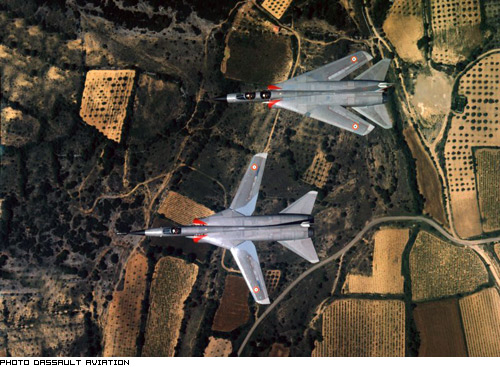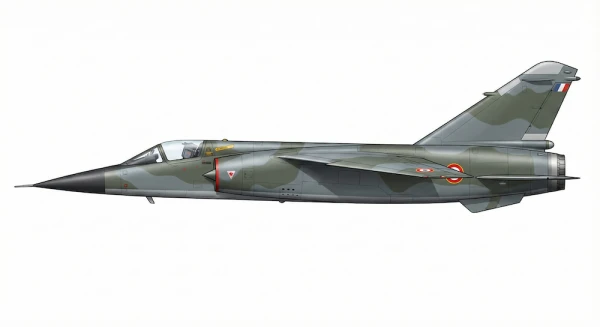Mirage G / G-4 / G-8
Summary
| Category | Combat Aircraft |
| Origin country | 🇫🇷 France |
| Manufacturer | Dassault |
| First flight | 18 November 1967 |
| Year introduced | |
| Number produced | 3 units |
| Average unit price | $25 million |
Description
In 1963, studies began within the French defence ministry concerning variable-sweep wing aircraft for both land and aircraft carrier applications. This initiative was influenced by the American TFX program. Avions Marcel Dassault initiated studies for a Mirage variant, including the Mirage F4G. In 1964, Dassault proposed the MD800 for a carrier-based naval version and the smaller, single-engined Mirage IIIF2G. In 1965, Dassault partnered with the British Aircraft Corporation (BAC) to develop an Anglo-French Variable Geometry (AFVG) aircraft, a collaboration which dissolved in 1967. The IIIF2G initiative led to the Mirage G prototype, configured as a single-seat, single-engined aircraft, which rolled out in 1967. The first flight of the Mirage G occurred on 18 November 1967. The prototype crashed on 13 January 1971 following a total loss of electrical power. By 1968, the twin-engine, two-seat Mirage G4 had been proposed as a nuclear strike fighter. This led to contracts for two prototypes, G4-01 and -02, which were later redesignated as the Mirage G8 interceptor. Mirage G8-01 first flew on 8 May 1971, followed by the second aircraft, G8-02, on 13 July 1972. The Mirage G program was canceled in 1968 due to projected funding limitations in the 1971-1976 French defence budget.
The Dassault Mirage G series incorporated a variable-sweep wing design. On the initial Mirage G prototype, the wing sweep could vary from 22 degrees when fully forward to 70 degrees when fully aft. This aircraft was also equipped with full-span double-slotted trailing edge flaps and two-position leading-edge flaps. The later Mirage G8 variant featured a Thomson-CSF radar system and utilized a low-altitude navigational-attack system derived from components developed for the SEPECAT Jaguar and Dassault Milan.
The proposed Mirage G4 variant was intended for the nuclear strike mission, indicating a planned capability to carry nuclear ordnance. The subsequent redesignation of the prototypes to the Mirage G8 interceptor role suggests potential integration of air-to-air missile systems, utilizing the installed Thomson-CSF radar for target engagement.
The operational history of the Dassault Mirage G series is limited to flight testing phases. The initial single-engine Mirage G prototype conducted flights from 1967 until its loss in a crash in 1971 caused by a total loss of electrical power. The twin-engine Mirage G8 prototypes underwent flight trials, with the first aircraft, G8-01, performing its initial flight in May 1971, and the second, G8-02, flying in July 1972. Despite successful flight test results, no production order was placed for the aircraft. The design influenced the Ling-Temco-Vought V-507 proposal in the United States, contributing technical data on variable-geometry wings during the competition for the US Navy's VFX carrier fighter contract, which was ultimately won by the Grumman F-14 Tomcat.
Main Variants:
-
F4G: An initial study conducted prior to the construction of the first prototype.
-
MD800: A submission for the DAFNE program in 1964.
-
G: The single-engine initial prototype; one example was flown starting in 1967.
-
G4 and G8: A twin-engine fighter project that began with two G4 nuclear strike fighter prototypes, but they were later redesignated as G8 interceptors during construction, with one flying as a two-seater and the other as a single-seater from 1968.
-
G8A or Super Mirage: A fixed-wing development of the G8 with a 55-degree sweepback; a 1973 contract for a prototype was canceled in 1975.
Technical specifications
| Version: Mirage G8 | |
|---|---|
| Crew | 1 pilot |
| Operational range | 3,850 km (2,392 mi) |
| Maximum speed | 2390 km/h (1485 mph) |
| Wing area | 37 m² (398.3 sqft) |
| Wingspan | 15.4 m (50.5 ft) |
| Height | 5.4 m (17.6 ft) |
| Length | 18.8 m (61.7 ft) |
| Service ceiling | 18,500 m (60,696 ft) |
| Empty weight | 14,740 kg (32,496 lbs) |
| Max. takeoff weight | 23,800 kg (52,470 lbs) |
| Powerplant | 2 x turbojets SNECMA Atar 9K50 delivering 5000 kgf each |
| Ejection seat | Martin-Baker Mk 4 |



